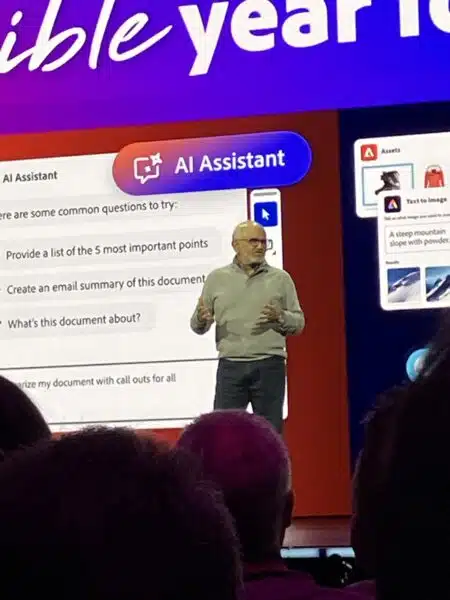Adobe continues to roll out genAI capabilities across its platform
Adobe continues to weave generative AI into applications across its platform in a series of new product announcements.
“When we think about the magic and value of AI, we know that it actually comes only from a seamless integration into the workflows that you, as customers, already know and love.”
That was the message from Adobe CEO Shantanu Narayen to his audience at the 2024 Adobe Summit as he announced the integration of Adobe Firefly Services (its flagship genAI offering) across Document Cloud, Creative Cloud and the applications with Experience Cloud, Adobe’s marketing and CX suite.
“Through every era, Adobe has tried to transform each of the experiences you can deliver across the entire customer end-to-end journey.” Adobe’s own journey, to combine the art of creativity with the science of marketing, began, said Narayen, in 2009. The vision was to create a single marketing stack combining content, data and journeys. Content, data and journeys, said Narayen, will remain at the core of how brands engage with customers.
“Over the years,” he said, “we’ve continued to expand and deliver on that vision of connecting all the dots across the customer experience value chain. We believe that customer experience management will again be transformed in the era of artificial intelligence.”
The theme of Summit has indeed been the intermeshing and growing interdependency of Adobe applications. There was a time when the creative capabilities such as Photoshop and Acrobat seemed almost isolated from Adobe’s marketing cloud offerings. That’s now far from the case.
Here are the main product announcements.

Adobe GenStudio for the content supply chain
Adobe also took further steps towards uniting its long-established creative solutions and its experience management offering by demonstrating an unbroken “content supply chain” workflow from ideation to publication and reporting. A central innovation here is the AI-powered Adobe GenStudio that will allow business users to take content from the planning and workflow stage (it integrates with Adobe Workfront) through creation and production (using Adobe Firefly), to management (it integrates with Adobe Experience Manager Assets), to delivery and performance evaluation (it integrates with Adobe Customer Journey Analytics). GenStudio will be available in Q3, 2024.
A demonstration illustrated the possibility of producing a very large numbers of brand-approved assets, adapted for a range of channels (email, social, etc.) in just a few minutes. The new Adobe Experience Manager Sites variant generation tool allows the rapid generation of variants of existing assets personalized for different audiences.
A new copilot
Threaded through the Experience Platform and apparently able to pop up almost anywhere is the new Adobe AI Assistant. Clicking on its icon opens a simple dialogue box into which the user can type natural language questions and instructions. The aim is to democratize an array of features, making them available to any business users. These include automation of tasks and workflows, generation of new journeys and audiences and simulation of outcomes. In a demonstration, the AI Assistant was used to narrow and focus audience segments through conversational exchanges.
PDFs, of course, are a sweet spot for Adobe, and AI Assistant can be used to analyze or generate summaries of documents of any length, or indeed convert them into presentations.
Journey Optimizer for B2B
Adobe Journey Optimizer will now be able to bring together both brand-initiated and customer-initiated interactions, making possible the creation of real-time personalized experiences across channels.
A new offering, Adobe Journey Optimizer B2B Edition, will enable marketers to target specific buying groups within accounts, an approach thought to be more focused than broader account-based marketing. It will be fully integrated with Marketo and also able to drive customer data back into Adobe Real-Time CDP.
Composability and a data clean room
Speaking of Real-Time CDP, it’s on the road to composability. Responding to concerns about the need to import or copy data into the CDP for activation purposes, it will now be possible for it to ingest brand data directly from where it resides in data warehouses or lakes including Snowflake, Google Cloud, AWS and others.
Adobe also announced Adobe Real-Time CDP Collaboration, a data clean room for brands and publishers to share and collaborate on audiences without risk to privacy.
Firefly is breeding new capabilities
Adobe Firefly, the generative AI suite released in beta a year ago, is rapidly breeding new capabilities. One eye-catching demo showed how in addition to mimicking an image style at the user’s request, it can now also mimic an image’s structure (the tools are called Style Reference and Structure Reference). The ability to use an existing image as a structural template will provide another way for brands to accelerate the generations of variants based on a brand-approved original.
Partners and sponsors
Adobe continues to build on its long-standing partnership with Microsoft, now bringing Experience Cloud customer insights and Firefly genAI directly into Microsoft applications.
It was also noteworthy that large agency holding companies such as IPG, Omnicom, Publicis and WPP had a prominent presence on the expo floor at Summit, as well as being among the main sponsors of the event. Adobe, in various degrees, is partnering with these companies on their own journeys from the traditional agency world to AI-powered customer engagement.
Related stories